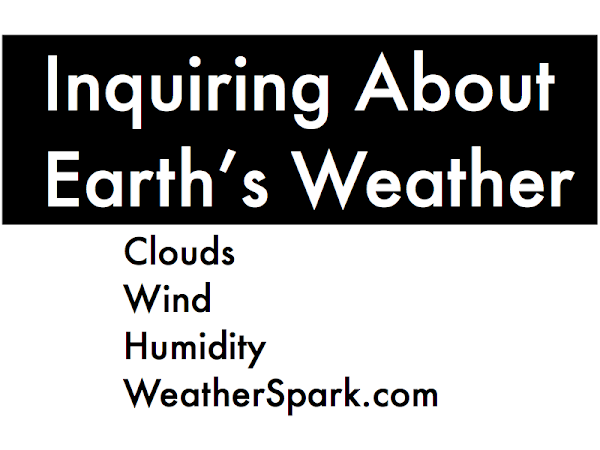 (This is the sixth Astronomy 210L laboratory at Cuesta College, San Luis Obispo, CA. This course is a one-semester, optional adjunct laboratory to the Astronomy 210 introductory astronomy lecture, taken primarily by students to satisfy their general education science transfer requirement.)
(This is the sixth Astronomy 210L laboratory at Cuesta College, San Luis Obispo, CA. This course is a one-semester, optional adjunct laboratory to the Astronomy 210 introductory astronomy lecture, taken primarily by students to satisfy their general education science transfer requirement.)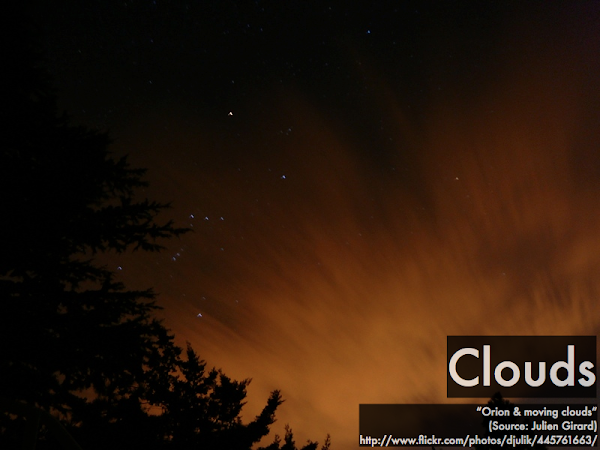 Cloud cover is not the only weather-related nemesis of astronomers.
Cloud cover is not the only weather-related nemesis of astronomers.The wind can be problematic as well, since we are observing at the bottom of an ocean of air. (Video link: "D90 HD Test 3.")
Any turbulence that stirs up the atmosphere will affect seeing, and cause distortions in telescope images (as well as twinkling the stars). (Video link: "Atmospheric Distortions.")
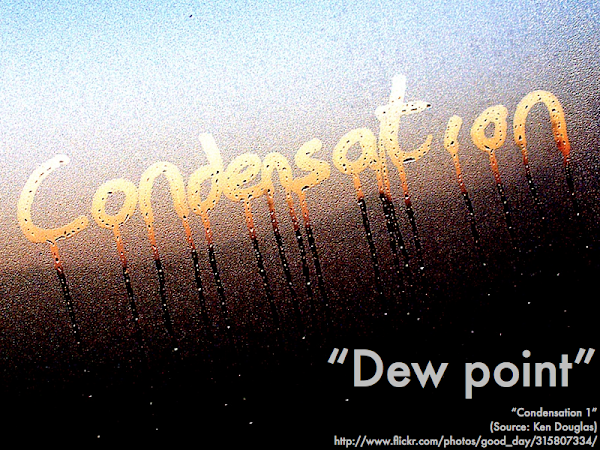 And even if the skies were clear and still, astronomers have one more weather-related pitfall: condensation forming on their telescopes. This happens when the air temperature falls below the dew point, where it becomes too cold for for water molecules to be suspended in the air, and they begin to glom onto each other and collect on cold surfaces. In order to prevent this, astronomers may resort to use heaters to warm up their telescopes if the temperature falls below the dew point, but while this will keep the telescope dry, it may also warm up the surrounding air and distort seeing.
And even if the skies were clear and still, astronomers have one more weather-related pitfall: condensation forming on their telescopes. This happens when the air temperature falls below the dew point, where it becomes too cold for for water molecules to be suspended in the air, and they begin to glom onto each other and collect on cold surfaces. In order to prevent this, astronomers may resort to use heaters to warm up their telescopes if the temperature falls below the dew point, but while this will keep the telescope dry, it may also warm up the surrounding air and distort seeing.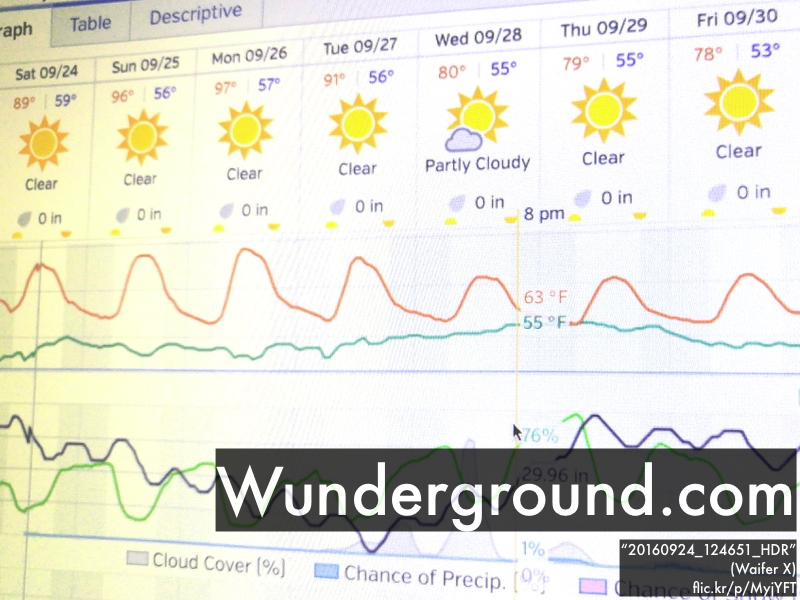
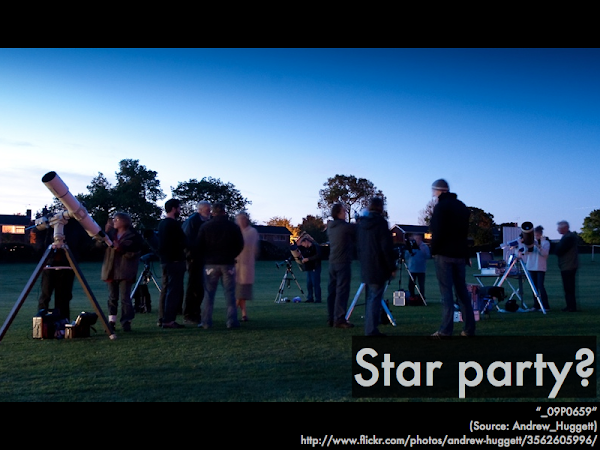 So next time you ever get to plan a star party...
So next time you ever get to plan a star party...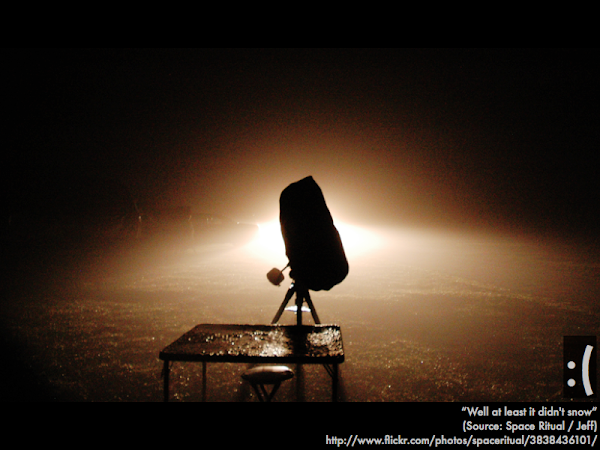 Heed the weather reports!
Heed the weather reports!Unless you operate radio telescopes, which are for the most part not affected by cloud cover, turbulence, or the dew point.
TASKS (as per Slater, Slater, Lyons, 2010, with the following modifications)
Computer Setup Access the nearest Weather Underground site for your campus by clicking on the appropriate link below:
*Main campus, San Luis Obispo, CA (*.html)Scroll down to the "10-Day Weather Forecast," and click on the "Customize" gear icon. Make sure that the following options are checked:
*North County campus, Paso Robles, CA (*.html)
*Dew PointClick the "Customize" gear icon when you are done. Click and hover your mouse over the graphs such that a vertical line appears, so you look up specific weather data values for each hour of the day. You can also click on the left "<" or right ">" arrows to look back at recorded past weather data, or forward to see future forecast weather data.
*Temperature
*Cloud Cover
*Chance of Precipitation
*Humidity
*Pressure
*Precipitation Accumulation Amount
*Hourly Liquid Precipitation
*Wind Speed
3. What Conclusions Can You Draw From This Evidence?
Wind is caused when air rapidly moves from one place to another. Typically best telescope viewing is done when the air is calm, to minimize "twinkling" from atmospheric turbulence. What conclusions and generalizations can you make from the following data collected by a student in terms of "What season of the year (in 2009) was best suited for telescope viewing in San Luis Obispo, CA?" by analyzing which season (winter, spring, summer, or fall) has the greatest or least peak wind speed, and most or least number of weeks with more than 50% cloud cover.
| Month (2009): | Peak Wind Speed (mph): | Weeks w/More than 50% Cloud Cover: | |
| Jan | 5.6 | 1.0 | |
| Feb | 6.7 | 1.5 | |
| Mar | 8.9 | 0.5 | |
| Apr | 11.0 | 1.0 | |
| May | 12.3 | 3.0 | |
| Jun | 7.8 | 1.0 | |
| Jul | 7.6 | 1.0 | |
| Aug | 9.2 | 1.0 | |
| Sep | 6.9 | 0.0 | |
| Oct | 7.4 | 1.0 | |
| Nov | 5.4 | 1.0 | |
| Dec | 5.4 | 1.0 |
Explain your reasoning and provide specific evidence, with sketches if necessary, to support your reasoning(*).
4. What Evidence Do You Need to Pursue?
Condensation is a common problem for telescopes:
You're out with your telescope on a pleasant summer evening, up late... You notice something strange. The dim stars begin to fade. The images of the bright stars suddenly have ghostly white haloes. And finally, you can barely see anything at all.The dew point is the temperature at which condensation starts to accumulate due to humidity. If the temperature of your telescope (approximately the same as the ambient air temperature) falls below the dew point, condensation will begin; if the temperature is above the dew point, no condensation forms. One method to actively prevent condensation is to use built-in electric warmers to keep the telescope temperature above the dew point. A dew warmer may affect observations by creating warm air updrafts, so a dew warmer should only be turned on when necessary.
The stars are gone.
You look at the sky. Have clouds rolled in? No. All clear.
Then, you take a peak [sic] at the lens of your telescope. A thick layer of water--dew--has condensed on your lens.
You don't dare wipe the dew off the lens for fear of damaging the soft anti-reflection coatings. And with no other way to remove the coating of water, your idyllic observing session has come to an early end. All you can do is pack up and go home, with your ambitious observing plan left undone.
What happened?
Condensation. The temperature of your telescope's lens fell below the so-called "dew point." And just as when you take a bottle of cold beer out the fridge, a swarm of water molecules from the surrounding air condensed onto the glass like locusts on a field of wheat.
--One Minute Astronomer Blog, "Don't 'Dew' This With Your Telescope...," April 29, 2010 (*.html)
Describe precisely what evidence you would need to collect and how to collect it in order to answer the research question of, "If a robotic telescope were to make continuous observations tonight, from one hour after sunset to one hour before sunrise tomorrow, what time(s) should the dew warmer be programmed to run?" (Running the dew warmer continuously all night may needlessly create local thermal drafts that would affect viewing.) You do not need to actually complete the steps in the procedure you are writing. (For the purposes of this activity, assume that the sky will be clear tonight for observations.)
Create a detailed, step-by-step description of evidence that needs to be collected and a complete explanation of how this could be done--not just "look up the dew point forecast," but exactly what would someone need to do, step-by-step, to accomplish this. You might include a table and sketches--the goal is to be precise and detailed enough that someone else could follow your procedure.
Reference:
- Tim Slater, Stephanie Slater, Daniel J. Lyons, Engaging in Astronomical Inquiry, W.H. Freeman & Company, New York, 2010, pp. 33-37,
http://www.whfreeman.com/newcatalog.aspx?disc=Astronomy+%26+Physics&course=Introduction+to+Astronomy&isbn=1429258608.




No comments:
Post a Comment